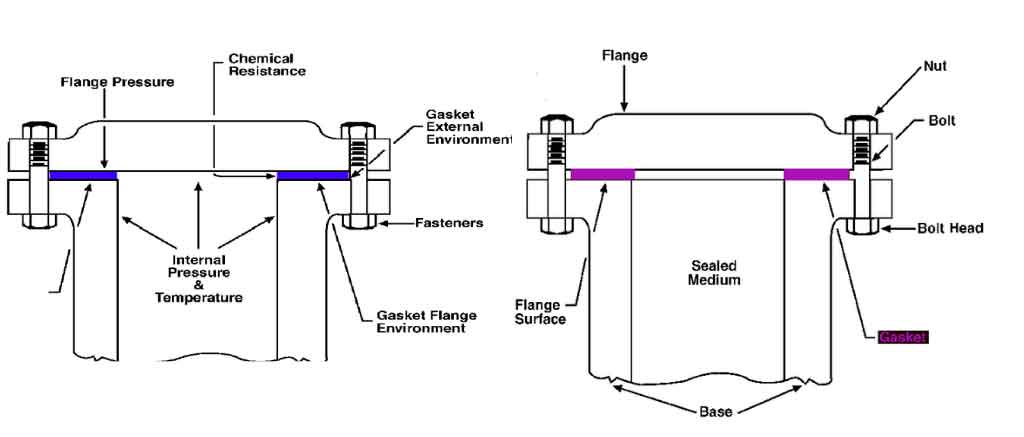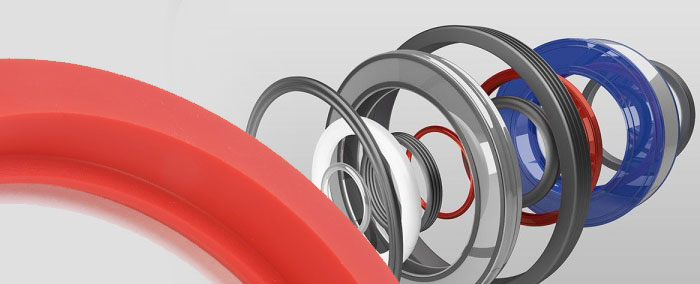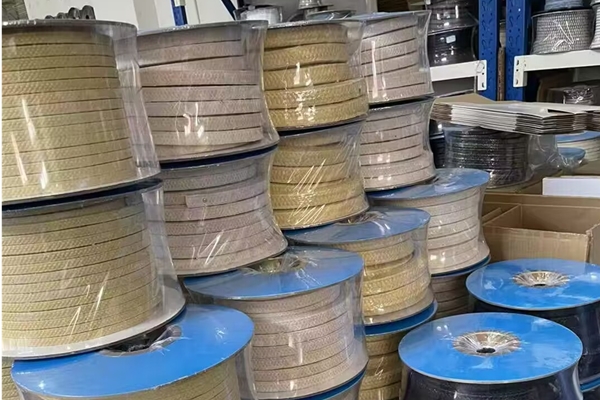It’s easy to find that gasket has been used in almost all industries, including food processing, petrochemicals, pharmaceuticals, water, and natural gas. You need to use it wherever a union or flange is required to prevent leaking. Many people confused it with a seal, however, there are different products although both of them perform essentially the same function.
1. What is a gasket?
Gaskets are usually used as static seals, it is an elastomeric component which designed for inclusions between two fixed parts of a flange joint. It can be made of different materials, such as metal, rubber, PTFE, graphite, mica, copper, etc materials. The choice of gasket material is based on its characteristics and ability to withstand different environments, such as mining and deep-sea, resistance to chemicals, alkaline acids, extreme temperatures, and pressures.
The main function of the gasket is to effectively seal and prevent the medium from leaking into the atmosphere. Besides, it is also used for many different purposes, including shockproof, packaging, sanitation, noise, and sound insulation.
2. Types of gasket
When selecting gaskets for your projects, you should consider both the mechanical characteristics and performance of a gasket, and these are decided by the type of gasket and materials. Gaskets can be clearly divided into three types, including non-metallic, semi-metallic, and metallic gaskets.

2.1 Metallic Gaskets
Metal gaskets are made of one or a combination of metals, which are designed to resist extreme temperatures, pressures, and chemical exposure. Compare to the non-metallic gaskets, metal gaskets can be used for higher quality surface sealing. These gaskets are a good fit for medium and high-pressure environments.
Metallic Gaskets Example:
- Ring joint gasket
- Special Ring Type Joint: AX type, IX type, Rubber Coated Ring Type Joint, Blind Ring Type Joint
- Lens Ring
- Other Metal Gasket: Convex Gasket, Delta Gasket, Metallic O-Ring
2.2 Semi-Metallic Gaskets
Semi-metallic gaskets are made of a mixture of metal and nonmetal materials. Metal can offer strength and elasticity, while non-metallic parts provide consistency and sealability.
With the semi-metallic design to resist high temperature and pressure, semi-metallic can be suitable for almost all working conditions, such as convex, internal and external convex, and tongue and groove flanges.
Semi-metallic Gaskets Example:
- Spiral wound gasket
- Cam profile (grooved) gasket
- Metal-reinforced graphite gaskets
- Metal jacketed gaskets
2.3 Non-Metallic Gaskets
With zero metal in its composition, a non-metallic gasket relates to a material that is easily compressed under bolt load, it can be chosen from a large variety of elastomers, compressed non-asbestos, PTFE, flexible graphite, and high-temperature sheet products.
As it can be bought in many cut shapes, sheets,s or rolls, non-metallic gaskets have been widely used in a lot of applications, including pipe flanges, heat exchangers, compressors, and bonnet valves.
Non-Metallic Gaskets material samples:
- Non-asbestos Gasket Sheet
- PTFE Tape Sealant Gasket
- PTFE Envelope Gaskets
- Expanded Graphite Gasket
- ePTFE gasket
- Mica Gasket
- Synthetic Fiber Rubber Gasket
3. How does a sealing gasket works?
There must be sufficiently compressed to create a complete barrier to make the gasket function effectively and seal any leaks. It can bring a pressure-tight seal to protect the contents within the seal. In addition, gaskets can protect moving parts, keep them away from hard friction surfaces and generate friction.

An elastic gasket (non-metallic gasket) can prevent the release or entry of gas and liquid, creating a seal between two surfaces. It is a very ideal design for filling deformation and connecting two surfaces together. Since the gaskets will fill the space between these two surfaces, they must be made of easily deformable materials and adequately fill any irregularities.
In order to make the metallic gasket can be sealed accurately, the metal gasket must be compressed under higher stress. In addition, in some cases, the sealant must be applied to the gasket to ensure a leak-free seal. (semi-metallic gaskets are included)
4. Flange Gasket Selection
Most testing for OEM products is conducted under laboratory conditions, so when you choosing the gasket material, actual field environments must be considered.
4.1 Key factors for Gasket Material selection
Here are some key factors we need to consider when selecting suitable flange gaskets:
- Temperature
When selecting gasket materials, the temperature is the most important factor you should consider. The operating temperature of the system is continuously close to the maximum temperature of the gasket material, we need to choose better gasket material.
- Chemical Compatibility
As there are many different fluids and gasses, we need to select the right gasket material which has good chemical compatibility with these media.
- Pressure
The internal pressure of the fluid is another decisive factor for gasket material selection. If severe cycles or pressure changes occur frequently, we need to choose a stronger gasket material.
- Application
All factors should be considered in the application, such as the number, grade, and size of bolts to create compression and the surface areas of the sealed joint. Since pressure and temperature are so closely linked, they are often considered together by measuring pressure x temperature or PXT value. If these values are continuously close to the maximum, you need to select a more robust gasket material.

4.2 Factors Affecting Gasket Performance
When selecting an industrial gasket, Longseal recommends using these 9 factors as a checklist from the perspective of the user’s demand for each factor and the manufacturer’s degree of compliance.
- Fluid sealing system.
- Chemically resist the system fluid to prevent serious damage to its physical properties.
- Enough deformation to flow into the defect of the gasket valve seat surface, thereby providing close contact between the gasket and the sealing surface.
- Able to withstand system temperature, and performance is not severely affected.
- It has sufficient elasticity and creeps resistance to maintain an appropriate partial load.
- It has sufficient strength to resist crushing under the applied load and maintain its integrity during handling and installation.
- Will not contaminate system fluids.
- Will not promote the corrosion of the gasket valve seat surface.
- Easy to clean and disassemble during replacement.
5. Industrial Gaskets Using FAQ
Here we list some common faqs for using industrial gaskets, if you still have any other problems about using the industrial gaskets, you can contact us and we will update it in time.
Q: How often should a gasket be changed?
Every time any equipment is taken apart and then reassembled, a new gasket should be used.
Q: What industries use gaskets?
Gaskets are used in many industries including oil and gas, pulp and paper, electric generation, and transportation.
Q: Are a gasket and a seal the same thing?
No, although a gasket and a seal perform the same function, there are different things. You can check this guide to know their difference: What is the difference between a gasket and a seal?
Q: What material can be used for gaskets?
Gaskets are usually made of flat materials, such as paper, rubber, silicone, metal, cork, felt, neoprene, nitrile rubber, glass fiber, polytetrafluoroethylene (or PTFE or Teflon), or Plastic polymers (such as polychlorotrifluoroethylene)
Q:What are the types of gaskets?
Gaskets can be divided into non-metallic gaskets (elastic gaskets), semi-metallic gaskets, and metal gaskets.
Q:What’s the purpose of the gasket?
The main function of the gasket is to effectively seal and prevent the medium from leaking into the atmosphere. Besides, it is also used for many different purposes, including shockproof, packaging, sanitation, noise, and sound insulation.
6. Conclusion
The gasket is a key element in many manufacturing processes because they are available in many specifications. There are very common components and can be found in a lot of applications, including cars, trains, planes, boats, electrical equipment, pumps. With the development of technology, better and better gaskets will be developed to serve more applications.




